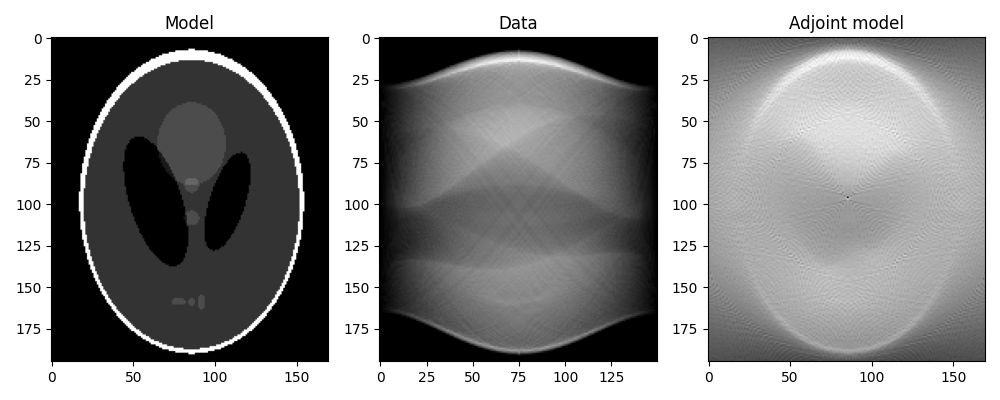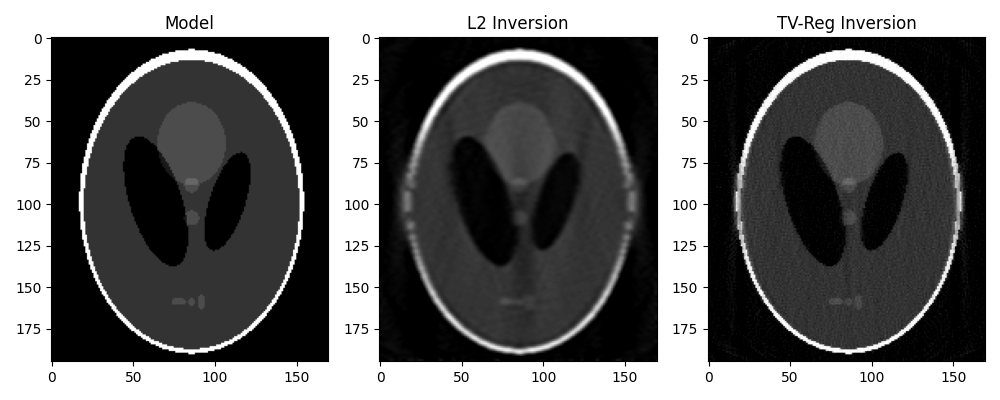Note
Click here to download the full example code
16. CT Scan Imaging¶
This tutorial considers a very well-known inverse problem from the field of medical imaging.
We will be using the pylops.signalprocessing.Radon2D operator
to model a sinogram, which is a graphic representation of the raw data
obtained from a CT scan. The sinogram is further inverted using both a L2
solver and a TV-regularized solver like Split-Bregman.
# sphinx_gallery_thumbnail_number = 2
import numpy as np
import matplotlib.pyplot as plt
import pylops
from numba import jit
plt.close('all')
np.random.seed(10)
Let’s start by loading the Shepp-Logan phantom model. We can then construct
the sinogram by providing a custom-made function to the
pylops.signalprocessing.Radon2D that samples parametric curves of
such a type:
where \(\theta\) is the angle between the x-axis (\(x\)) and the perpendicular to the summation line and \(r\) is the distance from the origin of the summation line.
@jit(nopython=True)
def radoncurve(x, r, theta):
return (r - ny//2)/(np.sin(np.deg2rad(theta))+1e-15) + np.tan(np.deg2rad(90 - theta))*x + ny//2
x = np.load('../testdata/optimization/shepp_logan_phantom.npy')
x = x / x.max()
ny, nx = x.shape
ntheta = 150
theta = np.linspace(0., 180., ntheta, endpoint=False)
RLop = \
pylops.signalprocessing.Radon2D(np.arange(ny), np.arange(nx),
theta, kind=radoncurve,
centeredh=True, interp=False,
engine='numba', dtype='float64')
y = RLop.H * x.T.ravel()
y = y.reshape(ntheta, ny).T
We can now first perform the adjoint, which in the medical imaging literature is also referred to as back-projection.
This is the first step of a common reconstruction technique, named filtered back-projection, which simply applies a correction filter in the frequency domain to the adjoint model.
xrec = RLop*y.T.ravel()
xrec = xrec.reshape(nx, ny).T
fig, axs = plt.subplots(1, 3, figsize=(10, 4))
axs[0].imshow(x, vmin=0, vmax=1, cmap='gray')
axs[0].set_title('Model')
axs[0].axis('tight')
axs[1].imshow(y, cmap='gray')
axs[1].set_title('Data')
axs[1].axis('tight')
axs[2].imshow(xrec, cmap='gray')
axs[2].set_title('Adjoint model')
axs[2].axis('tight')
fig.tight_layout()

Finally we take advantage of our different solvers and try to invert the modelling operator both in a least-squares sense and using TV-reg.
Dop = [
pylops.FirstDerivative(ny * nx, dims=(nx, ny), dir=0, edge=True, dtype=np.float),
pylops.FirstDerivative(ny * nx, dims=(nx, ny), dir=1, edge=True, dtype=np.float)]
D2op = pylops.Laplacian(dims=(nx, ny), edge=True, dtype=np.float)
# L2
xinv_sm = \
pylops.optimization.leastsquares.RegularizedInversion(RLop.H,
[D2op],
y.T.flatten(),
epsRs=[1e1],
**dict(iter_lim=20))
xinv_sm = np.real(xinv_sm.reshape(nx, ny)).T
# TV
mu = 1.5
lamda = [1., 1.]
niter = 3
niterinner = 4
xinv, niter = pylops.optimization.sparsity.SplitBregman(RLop.H, Dop, y.T.flatten(), niter, niterinner,
mu=mu, epsRL1s=lamda, tol=1e-4, tau=1., show=False,
**dict(iter_lim=20, damp=1e-2))
xinv = np.real(xinv.reshape(nx, ny)).T
fig, axs = plt.subplots(1, 3, figsize=(10, 4))
axs[0].imshow(x, vmin=0, vmax=1, cmap='gray')
axs[0].set_title('Model')
axs[0].axis('tight')
axs[1].imshow(xinv_sm, vmin=0, vmax=1, cmap='gray')
axs[1].set_title('L2 Inversion')
axs[1].axis('tight')
axs[2].imshow(xinv, vmin=0, vmax=1, cmap='gray')
axs[2].set_title('TV-Reg Inversion')
axs[2].axis('tight')
fig.tight_layout()

Total running time of the script: ( 0 minutes 10.427 seconds)